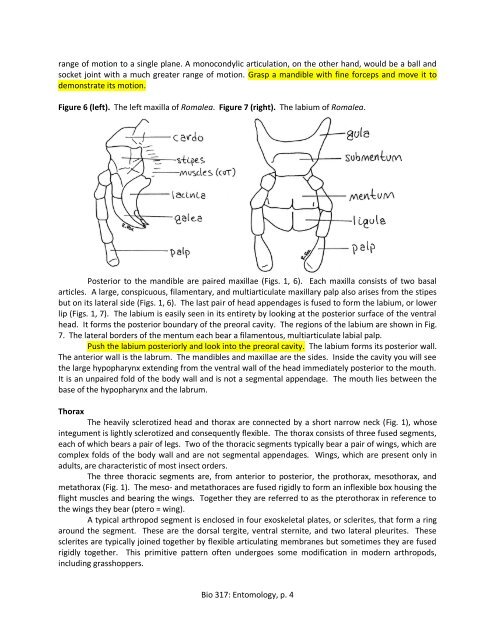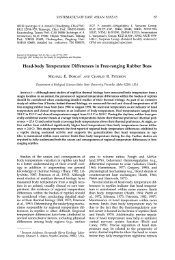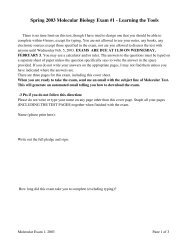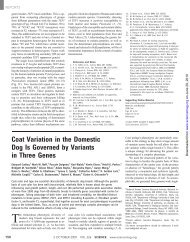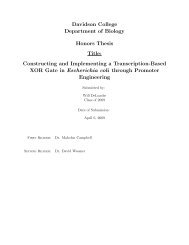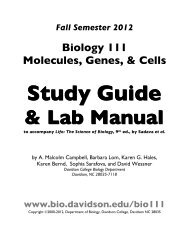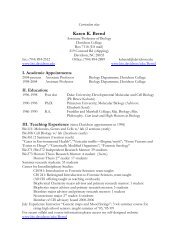Exercise 3: Internal Anatomy of the Lubber Grasshopper, Romalea
Exercise 3: Internal Anatomy of the Lubber Grasshopper, Romalea
Exercise 3: Internal Anatomy of the Lubber Grasshopper, Romalea
Create successful ePaper yourself
Turn your PDF publications into a flip-book with our unique Google optimized e-Paper software.
ange <strong>of</strong> motion to a single plane. A monocondylic articulation, on <strong>the</strong> o<strong>the</strong>r hand, would be a ball and<br />
socket joint with a much greater range <strong>of</strong> motion. Grasp a mandible with fine forceps and move it to<br />
demonstrate its motion.<br />
Figure 6 (left). The left maxilla <strong>of</strong> <strong>Romalea</strong>. Figure 7 (right). The labium <strong>of</strong> <strong>Romalea</strong>.<br />
Posterior to <strong>the</strong> mandible are paired maxillae (Figs. 1, 6). Each maxilla consists <strong>of</strong> two basal<br />
articles. A large, conspicuous, filamentary, and multiarticulate maxillary palp also arises from <strong>the</strong> stipes<br />
but on its lateral side (Figs. 1, 6). The last pair <strong>of</strong> head appendages is fused to form <strong>the</strong> labium, or lower<br />
lip (Figs. 1, 7). The labium is easily seen in its entirety by looking at <strong>the</strong> posterior surface <strong>of</strong> <strong>the</strong> ventral<br />
head. It forms <strong>the</strong> posterior boundary <strong>of</strong> <strong>the</strong> preoral cavity. The regions <strong>of</strong> <strong>the</strong> labium are shown in Fig.<br />
7. The lateral borders <strong>of</strong> <strong>the</strong> mentum each bear a filamentous, multiarticulate labial palp.<br />
Push <strong>the</strong> labium posteriorly and look into <strong>the</strong> preoral cavity. The labium forms its posterior wall.<br />
The anterior wall is <strong>the</strong> labrum. The mandibles and maxillae are <strong>the</strong> sides. Inside <strong>the</strong> cavity you will see<br />
<strong>the</strong> large hypopharynx extending from <strong>the</strong> ventral wall <strong>of</strong> <strong>the</strong> head immediately posterior to <strong>the</strong> mouth.<br />
It is an unpaired fold <strong>of</strong> <strong>the</strong> body wall and is not a segmental appendage. The mouth lies between <strong>the</strong><br />
base <strong>of</strong> <strong>the</strong> hypopharynx and <strong>the</strong> labrum.<br />
Thorax<br />
The heavily sclerotized head and thorax are connected by a short narrow neck (Fig. 1), whose<br />
integument is lightly sclerotized and consequently flexible. The thorax consists <strong>of</strong> three fused segments,<br />
each <strong>of</strong> which bears a pair <strong>of</strong> legs. Two <strong>of</strong> <strong>the</strong> thoracic segments typically bear a pair <strong>of</strong> wings, which are<br />
complex folds <strong>of</strong> <strong>the</strong> body wall and are not segmental appendages. Wings, which are present only in<br />
adults, are characteristic <strong>of</strong> most insect orders.<br />
The three thoracic segments are, from anterior to posterior, <strong>the</strong> prothorax, mesothorax, and<br />
metathorax (Fig. 1). The meso- and metathoraces are fused rigidly to form an inflexible box housing <strong>the</strong><br />
flight muscles and bearing <strong>the</strong> wings. Toge<strong>the</strong>r <strong>the</strong>y are referred to as <strong>the</strong> pterothorax in reference to<br />
<strong>the</strong> wings <strong>the</strong>y bear (ptero = wing).<br />
A typical arthropod segment is enclosed in four exoskeletal plates, or sclerites, that form a ring<br />
around <strong>the</strong> segment. These are <strong>the</strong> dorsal tergite, ventral sternite, and two lateral pleurites. These<br />
sclerites are typically joined toge<strong>the</strong>r by flexible articulating membranes but sometimes <strong>the</strong>y are fused<br />
rigidly toge<strong>the</strong>r. This primitive pattern <strong>of</strong>ten undergoes some modification in modern arthropods,<br />
including grasshoppers.<br />
Bio 317: Entomology, p. 4


